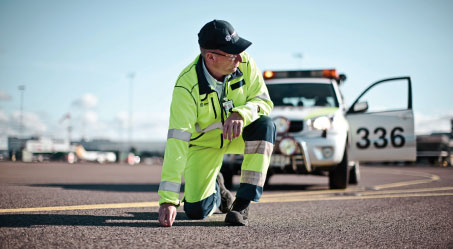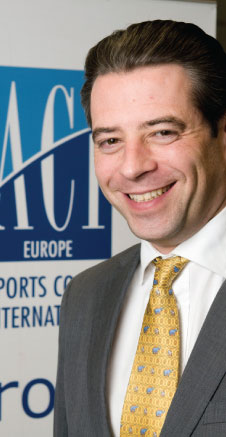
The EASA Rulemaking Process for the new regulatory system for aerodrome safety reached an important stage in December 2011, when the Notice of Proposed Amendments was published. The ACI EUROPE EASA Task Force has been deeply involved in the Rulemaking Process and has fed its expertise to the experts in the Rulemaking Groups. This has ensured proper involvement of the ACI EUROPE membership.
The collaboration between ACI EUROPE and EASA has evolved extremely well over the past years and the airport community can be confident that it has had sufficient input into the process. “It was, and still is, absolutely critical to involve the industry expertise in order to ensure flexibility and operational feasibility,” commented Ahrens. “We highly appreciate the cooperative approach EASA has taken in the whole Rulemaking Process so far.”
ACI EUROPE and individual airports have been formal contributors to the Rulemaking Process as members of the established Working Group. “The intention has been and still is to involve experts from industry and Member States to the fullest extent possible,” explained Kessler. “We are glad to see that the airport community has accepted this opportunity to contribute, and an intense, excellent level of cooperation and constant communication has been very encouraging for us. The airports are at the heart of the development, and there is plenty of evidence of the fruitfulness of this contribution. It is absolutely necessary!”
Airports always had three representatives in each of the three Rulemaking Groups, while the ACI EUROPE EASA Taskforce has been deeply involved in the Rulemaking Process and has provided its expertise to the representatives in the Rulemaking Groups. This has ensured proper involvement of the ACI EUROPE membership.
Small aerodromes represented

Kessler: “We are glad to see that the airport community has accepted this opportunity to contribute, and an intense, excellent level of cooperation and constant communication has been very encouraging for us. The airports are at the heart of the development, and there is plenty of evidence of the fruitfulness of this contribution. It is absolutely necessary!”
The scope of the future European rules will encompass most civil IFR (Instrument Flight Rules) airports, from global hubs to small airports serving marginal commercial traffic. “All involved actors, therefore, used great care to accommodate respective aspects by flexible, proportionate rules,” said Kessler. “The involvement of ERAC and case studies of some small airports, especially in France and Switzerland have been fairly instrumental in avoiding unintended, undue effects.”
Ahrens added that ERAC and operators such as Avinor and BAA, which also operate smaller aerodromes, were very helpful in sharing their experience and knowledge with regard to small aerodromes.
No major “sticking points”
As far as ACI EUROPE’s commonly agreed comments – covering the whole membership – on the Notice of Proposed Amendments (NPA) are concerned, it has not identified any “sticking point”. Ahrens said: “There is still room for fine-tuning and getting things absolutely right, but this will be addressed through our NPA. Some regions in Europe might have some specific legal issues with their national legislations, which have to be addressed from their side individually.”
Kessler explained that the delicate issues have been apparent from an early stage in the process: continuity, flexibility and light conversion mechanisms for airports also by possible acceptance of existing deviations. “These important, key coordinates have been given a lot of thought along the process and the feedback is encouraging. So, while there is still ample room to fine-tune and improve the proposed rules, we should have got the overall frame right and removed possible “sticking points” already,” he commented.
It was decided by all to base the proposed rules on “mature” ICAO text. Therefore, by and large, formally adopted ICAO material is being transposed, while in some areas “ready to be agreed” text has been taken.
While the NPA is a daunting 740+ pages, Kessler stated that huge effort has been made to highlight the most important, as well as the “new” elements, meaning the actual hard rules involve only around 65 pages. Ahrens added that “Most of the rules are familiar to our members since they are based on ICAO Annex 14 and other existing material – something we have always asked for since the beginning of the process.”
EASA proposes that for all existing infrastructure related deviations, not only for those filed to ICAO, the competent authorities can opt to have those sustained if found to be safe. “This element of flexibility is crucial,” commented Kessler.
This is something ACI EUROPE argued strongly for and Ahrens noted that a special task force of the EASA Aerodrome High Level Group tackled just this very important issue. “Provisions for this are currently in the NPA and we strongly support this, and I would like to encourage our whole membership to do so, too!” he said.
‘Harmonised level of safety’

Ahrens: “It was, and still is, absolutely critical to involve the industry expertise in order to ensure flexibility and operational feasibility. We highly appreciate the cooperative approach EASA has taken in the whole Rulemaking Process so far.”
EASA does not foresee potential geographical problems for implementation in certain Member States, as adequate room to address local specificities is given by the proposed rules. “Special solutions, which had been found acceptable by the authorities in the past, can be sustained and continuity is ensured,” stated Kessler.
In advance of the Rulemaking Process, EASA carried out a study to check which Member States apply ICAO Annex 14. The results indicated that a set of European Rules will be useful to ensure a unified level of safety in Europe. “Some States follow more than others and the new rules should help to have a harmonised level of safety in Europe for our customers, the passengers and airlines alike,” commented Ahrens.
Both Ahrens and Kessler stressed that airports will not have to be certified by EASA in the future – certification will be done by the National Aviation Authorities. From this point of view nothing will change for airports, except the rules the certification is based upon, which will differ a little due to the new set of EASA Rules.
Regarding the preparedness of National Authorities for the EASA Rules, the impact assessment has not revealed any stumbling blocks, but Kessler explained that the issue will be looked at again when additional light is shed on it via the ongoing consultation.
Ahrens said: “In the rulemaking discussions with the NAAs, we could often find common ground and there should not be major ‘sticking points’. The EASA rules will feel like new rules – although they are based on existing material – and therefore we need to reduce the scepticism. It seems key for the successful certification process that Member States ensure sufficient staffing and do not cut jobs now – the completely wrong time to do so!”
Kessler foresees no problems or significant challenges with adoption of the rules from January 2014. “If we all do our job correctly, we will be looking at some level of due and reasonable adjustments, but no disruptions, and especially no significant economic burden. This should go for all affected airports, and it is exactly this spirit on which we need to base the project,” he asserted.
Ahrens added: “I believe we are on a good track with the EASA rules. It is a matter of the spirit with which we tackle the initial certification. The Basic Regulation is there, we need to make the best out of it – which we did so far – and should therefore be able to comply with the rules.”
Additionally, both Kessler and Ahrens are adamant that there will be no explosion in costs for European airports to cover the new set of rules. The formal consultation period on the NPA will continue until end-April 2012. A review of the comments received will follow in the subsequent months, potentially again involving industry experts. A Comment Response Document (CRD) will then be published – again asking for formal comments. The formal EASA decision and opinion will be published in late-2012 and handed over to the European Commission for adoption. This adoption process, via comitology, is expected to take up to a year and will be complete by end-2013. The constant exchange and communication between EASA and the airport industry will continue. “Our members are eager to stay involved in the process and are more than happy to continue to exchange their expertise with EASA whenever needed in the process. It’s the best way to address all the possible concerns that airports may have,” concluded Ahrens.







